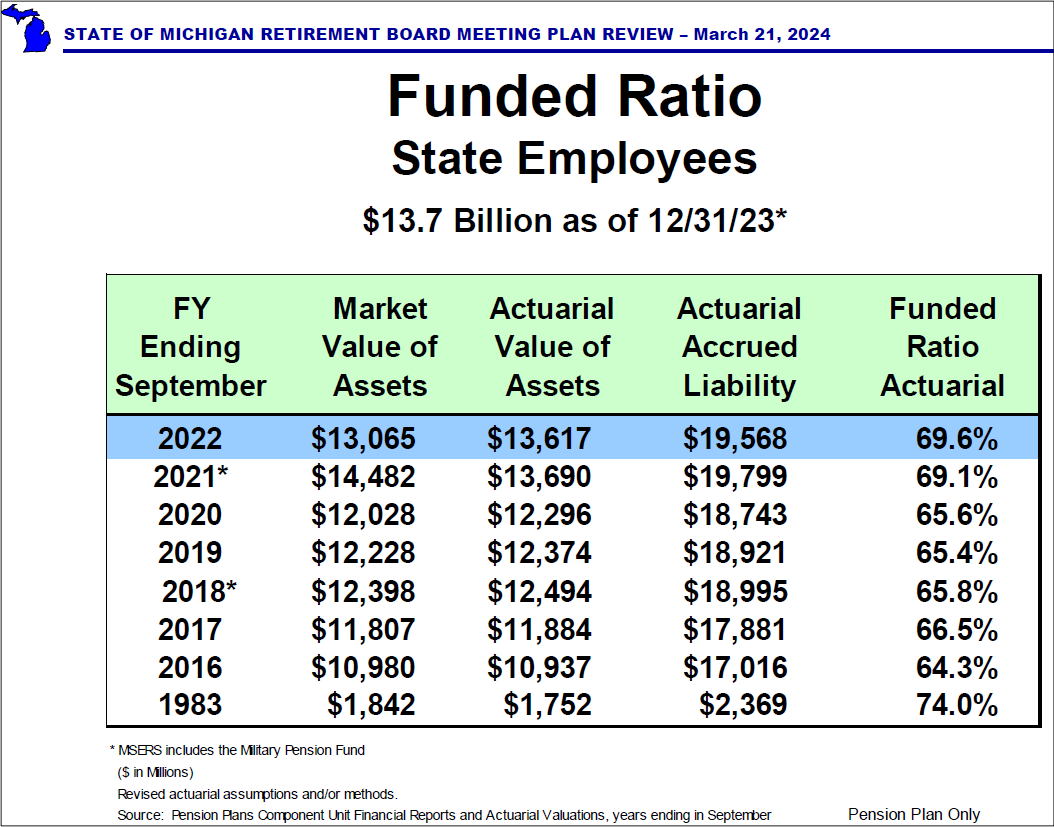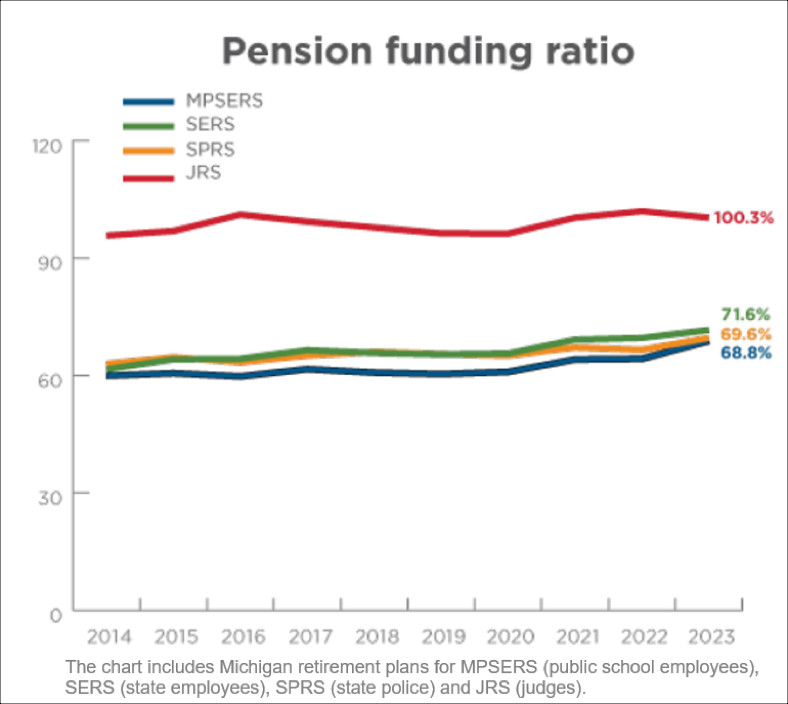
Retirement Matters
May 2024
Pension Rate of Returns — The good news is that State Employee Retirement System (SERS) pension investments have performed well. The ten-year time-weighted rate of return is 9 percent as of 12/31/2023. In addition, SERS returns substantially beat their public plan peers, across all longer time periods. The long-term return is significant because it’s what the pension system depends on. We will reap the benefits from these returns because they will more fully fund and stabilize the plan. Like most states, Michigan has not completely funded their public pension systems.
Progress over the last year is measured by the one-year rate of return of 9.8 percent. See Time-Weighed Rates of Return chart below. This is much higher than the assumed rate of return (AROR) of 6 percent. Yes, long run market returns continue to be strong for pension funds even with global and domestic volatility and challenges. But these positive rates of return don’t just happen in a vacuum. Michigan’s state government officials, alongside investment and actuarial professionals, have managed our retirement system wisely, with strong funding policies in place, and by reinvesting the earnings back into the plan.
SERS Pension Funded Ratio — The funded ratio measures how much of our SERS retiree benefits are paid up. It compares the dollars in the fund to the value of promised lifetime income benefits. A funded ratio below 100 percent means that the plan has not saved enough. See the chart for the SERS Funded Actuarial Ratio, for pensions only, which has hovered around 64 percent to 66 percent from Fiscal 2016 to 2020. By Fiscal 2022, this ratio reached 69.6 percent according to the Michigan Bureau of Investments. This is based on $13,617 million in actuarial value of assets compared to $19,568 million in actuarial value of liability, as of December 31, 2023. Note that this funded ratio continued to improve, from Fiscal 2020 onward, despite the pandemic’s negative economic impact. See Funded Ratio chart.
Actuarial Process — To measure the value of benefits (liabilities) promised by the Michigan retirement system to the retiree membership, the actuary must make a number of economic and demographic assumptions regarding future experience. These assumptions include long-term rates of investment return; retirement rates among active members; and mortality rates among active members, retirees and beneficiaries. These assumptions impact the annual actuarially determined contribution (ADC) funded by the State. Actuarial assumptions are set with joint approval by the Department of Technology, Management, and Budget Director and the retirement boards after consultation with the State Treasurer and the plan actuary.
Upward Trend Continues — This SERS funded ratio has reached an estimated 71.6 percent for Fiscal 2023 based on a newly released draft, according to an Office of Retirement Services (ORS) presentation to SERA in May 2024. The Pension Funding Ratio chart shows a historical trend back to 2014. The SERS funded pension ratio, is shown by the line ending with 71.6 percent.
SERS Health Care Funded Ratio — The ratio for health care is based on an actuarial valuation which assesses the long-term sustainability of health benefits and helps plan sponsors to make decisions. Most state governments provide access to health benefits for qualifying defined benefit retired employees. According to the Equable Institute, Michigan ranks high among the states in pre-funding of retiree health benefits. The SERS health care funded ratio has moved along a fairly upward trend from just over 10 percent in 2014 to an estimated 85.8 percent for 2023 in a recent draft. See the Retiree Healthcare Funding Ratio chart for the SERS retiree health care funding ratio which is the line ending with 85.8 percent. This is a phenomenal success. It’s a stunning example of how government has worked for you.Paying Off SERS Benefits — The liability for SERS is expected to be paid off by 2036 for pensions and Other Post Employment Benefits (OPEB) which are benefits other than pension distributions such as paid health insurance, life insurance, and deferred compensation. The biggest factors influencing this funding status includes large market losses from global downturns in the early 2000s and 2008-2009 and several early retirement incentives from 1984 to 2010. Turning now to other pocketbook matters.
Unjustified Utility Rate Increases — Over time, high utility rate increases have eroded pension and Social Security benefits that haven’t received adequate Cost of Living Adjustments (COLA). Since taking office in 2019, Michigan’s Attorney General (AG) Dana Nessel has intervened on behalf of Michigan utility customers to protect them from exorbitantly high utility rate hikes. Here’s a Michigan elected official that has taken her office seriously, improving the financial strength of customers. She has steadfastly taken action to help save Michigan consumers over $3 billion by intervening in utility cases before the Michigan Public Service Commission (MPSC). This commitment to ensure affordable energy for consumers has spared retirees from recent unreasonable utility rate hikes. This provides significant relief to retirees with low, fixed incomes, who could have had their purchasing power further eroded, making it difficult to pay for basic necessities.
Rapid Utility Rate Increases — Utility companies are asking for rate increases just one right after the other. DTE Electric’s most recent rate increase request of $450 million was made only four months after the last one of $368 million was approved, a move which cost the residential average customer about $100 a month. The newest request would have been effective in January 2025. It attempts to pass costs on to consumers. But when DTE was questioned by AG Nessel, it has frequently failed to justify the increased burden or explain the cost. In addition, AG Nessel has criticized DTE’s $9 billion five-year plan, advocating for affordability and accountability instead. To provide information to customers, she has launched a new website on utility cases and power outages.
Consumers Energy (CE) — CE asked for a rate increase of $136 million, just one month after it received approval of its natural gas rate increase. The request is a 37 perent increase in residential monthly charges. AG Nessel provided evidence that 96 percent of CE’s gas rate request should be eliminated and customers should get a reduction instead. It appears that CE wants to increase the shareholders financial gain at the expense of its customers.
Editor’s note: Joanne Bump serves as feature columnist for “Retirement Matters.” Column content is time sensitive and is based on information as of 5/5/24. Joanne can be contacted by e-mail at joannebump@gmail.com.
Return to top of page



